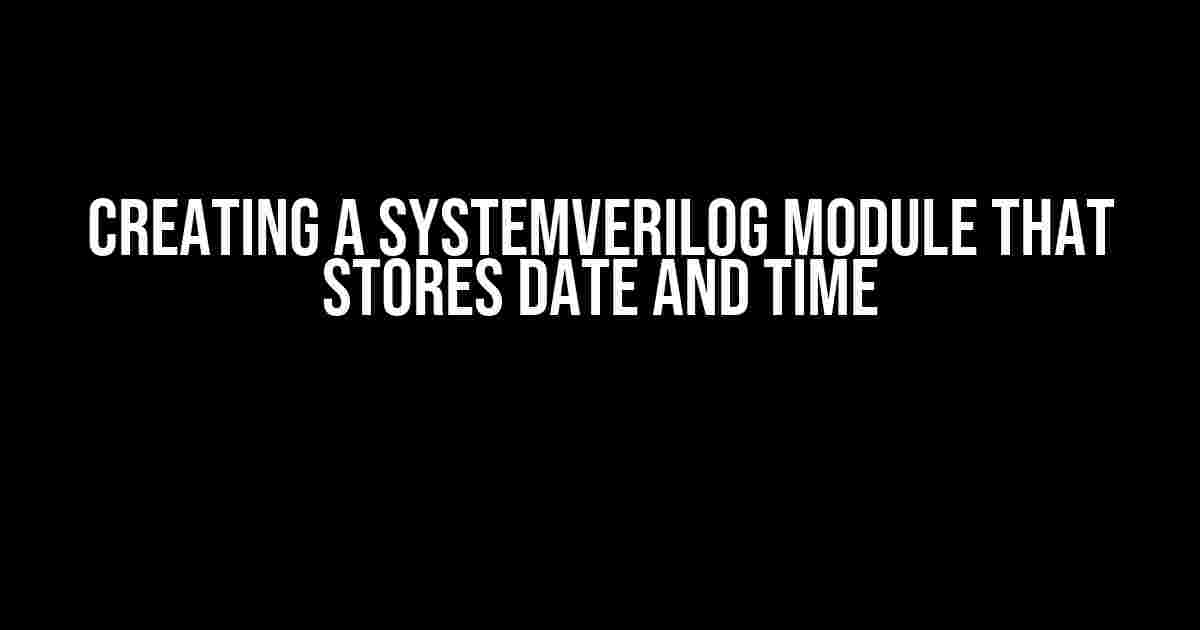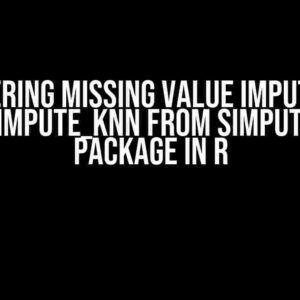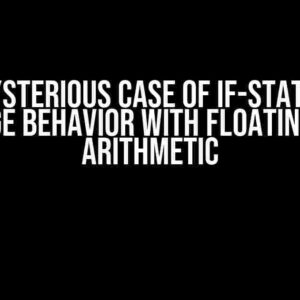As digital designers, we often encounter scenarios where we need to store and manipulate date and time in our designs. Whether it’s for scheduling tasks, tracking events, or simply displaying the current time, having a reliable and efficient way to handle date and time is crucial. In this article, we’ll explore how to create a SystemVerilog module that stores and manipulates date and time.
Why SystemVerilog?
SystemVerilog is a powerful hardware description language (HDL) that’s widely used in the digital design industry. Its object-oriented programming (OOP) features, assertions, and coverage analysis make it an ideal choice for complex digital designs. Moreover, SystemVerilog’s ability to model and verify digital systems at various abstraction levels makes it a popular choice for designers and verification engineers.
The Problem: Storing Date and Time
Storing date and time in a digital design can be challenging, especially when considering the various formats, time zones, and leap year rules. A simple approach might be to use a 32-bit integer to store the number of seconds since a reference date, such as January 1, 1970. However, this approach has limitations, such as:
- It doesn’t account for leap years and daylight saving time (DST) adjustments.
- It’s not easily readable or manipulable.
- It’s limited to a specific date range.
A more robust approach is to create a SystemVerilog module that can store and manipulate date and time in a flexible and accurate manner.
The Solution: SystemVerilog Module
Let’s create a SystemVerilog module that stores date and time using a structured approach. We’ll define a `datetime` struct to hold the date and time components, and a `datetime_module` module to manipulate and store these components.
typedef struct {
int year;
int month;
int day;
int hour;
int minute;
int second;
} datetime;
module datetime_module (
input logic clk,
input logic reset,
input datetime dt_in,
output datetime dt_out
);
In this module, we’ve defined a `datetime` struct with six components: `year`, `month`, `day`, `hour`, `minute`, and `second`. We’ll use this struct to store and manipulate the date and time.
Initialization and Reset
To ensure the module is properly initialized, we’ll add a reset signal that sets the `datetime` components to a default value.
always @(posedge clk or posedge reset) begin
if (reset) begin
dt_out.year <= 1970;
dt_out.month <= 1;
dt_out.day <= 1;
dt_out.hour <= 0;
dt_out.minute <= 0;
dt_out.second <= 0;
end else begin
// Update dt_out based on dt_in
end
end
In this code snippet, we've added a reset signal that sets the `datetime` components to a default value when triggered. The `posedge clk` statement ensures that the module is triggered on the rising edge of the clock signal.
Now that we have a basic structure in place, let's add functionality to manipulate the date and time. We'll create three functions: `inc_second`, `inc_minute`, and `inc_hour` to increment the second, minute, and hour components, respectively.
function void inc_second(ref datetime dt);
dt.second++;
if (dt.second == 60) begin
dt.second = 0;
inc_minute(dt);
end
endfunction
function void inc_minute(ref datetime dt);
dt.minute++;
if (dt.minute == 60) begin
dt.minute = 0;
inc_hour(dt);
end
endfunction
function void inc_hour(ref datetime dt);
dt.hour++;
if (dt.hour == 24) begin
dt.hour = 0;
// Update day, month, and year if necessary
end
endfunction
In these functions, we've used the `ref` keyword to pass the `datetime` struct by reference, allowing us to modify its components directly. We've also added logic to handle rollbacks when the second, minute, or hour components reach their maximum values.
Leap Year and DST Handling
To account for leap years and DST adjustments, we'll add additional logic to our `inc_day` function.
function void inc_day(ref datetime dt);
dt.day++;
if (dt.day > days_in_month(dt.month, dt.year)) begin
dt.day = 1;
inc_month(dt);
end
endfunction
function int days_in_month(int month, int year);
case (month)
1, 3, 5, 7, 8, 10, 12: return 31;
2: begin
if (is_leap_year(year)) return 29;
else return 28;
end
default: return 30;
endcase
endfunction
function bit is_leap_year(int year);
return (year % 4 == 0 && year % 100 != 0) || year % 400 == 0;
endfunction
In this code snippet, we've added a `days_in_month` function to determine the number of days in a given month, taking into account leap years. We've also added an `is_leap_year` function to check if a year is a leap year.
Using the Datetime Module
Now that we have a fully functional `datetime_module`, let's see how to use it in a simple design.
module top (
input logic clk,
input logic reset
);
datetime dt_in, dt_out;
datetime_module datetime_inst (
.clk(clk),
.reset(reset),
.dt_in(dt_in),
.dt_out(dt_out)
);
initial begin
dt_in.year = 2022;
dt_in.month = 6;
dt_in.day = 15;
dt_in.hour = 12;
dt_in.minute = 0;
dt_in.second = 0;
end
always @(posedge clk) begin
dt_in.second++;
datetime_inst.dt_in = dt_in;
end
endmodule
In this example, we've instantiated the `datetime_module` and connected it to a clock signal and a reset signal. We've also defined an initial value for the `datetime` struct and increment the second component on each clock cycle.
Conclusion
In this article, we've explored how to create a SystemVerilog module that stores and manipulates date and time. We've defined a `datetime` struct to hold the date and time components, and a `datetime_module` module to initialize, reset, and manipulate these components. We've also added functionality to handle leap years and DST adjustments.
This module can be used in a variety of digital designs, from scheduling tasks to tracking events. By following the instructions and explanations provided in this article, you'll be able to create a reliable and efficient way to handle date and time in your designs.
Takeaway Points
- Create a SystemVerilog module to store and manipulate date and time.
- Use a structured approach with a `datetime` struct to hold the date and time components.
- Implement functions to increment the second, minute, and hour components.
- Account for leap years and DST adjustments.
- Use the module in a simple design to demonstrate its functionality.
FAQs
| Q | A |
|---|---|
| What is the purpose of the `datetime` struct? | To hold the date and time components in a structured manner. |
| How do I handle leap years and DST adjustments? | Use the `days_in_month` function to determine the number of days in a month, and the `is_leap_year` function to check if a year is a leap year. |
| What is the advantage of using SystemVerilog for digital designs? | SystemVerilog's object-oriented programming features, assertions, and coverage analysis make it an ideal choice for complex digital designs. |
By following the instructions and explanations provided in this article, you'll be able to create a reliable and efficient SystemVerilog module that stores and manipulates date and time. Remember to account for leap years and DST adjustments, and use the module in a simple design to demonstrate its functionality.
Frequently Asked Questions
Get the scoop on SystemVerilog modules that store date and time!
What is the purpose of a SystemVerilog module that stores date and time?
The purpose of a SystemVerilog module that stores date and time is to provide a reusable component that can be used to capture and manipulate date and time information within a digital system. This module can be used in a variety of applications, such as timestamping events, scheduling tasks, or generating time-stamped data.
What are the common components of a SystemVerilog module that stores date and time?
A typical SystemVerilog module that stores date and time includes components such as registers to store the date and time values, a clock input to drive the time-keeping mechanism, and logic to perform date and time calculations, such as incrementing the time or calculating the day of the week.
How does a SystemVerilog module that stores date and time handle leap years?
A SystemVerilog module that stores date and time typically includes logic to handle leap years by adding an extra day to the month of February in years that are divisible by 4 (except for years that are divisible by 100 but not by 400).
Can a SystemVerilog module that stores date and time be used in a pipelined architecture?
Yes, a SystemVerilog module that stores date and time can be used in a pipelined architecture by adding pipeline registers to store the date and time values at each stage of the pipeline. This allows the module to operate in a pipelined fashion, processing multiple date and time values concurrently.
How can a SystemVerilog module that stores date and time be tested and verified?
A SystemVerilog module that stores date and time can be tested and verified using a combination of simulation-based verification and formal verification techniques. This includes writing testbenches to exercise the module with different input scenarios and using assertion-based verification to check the correctness of the module's behavior.





